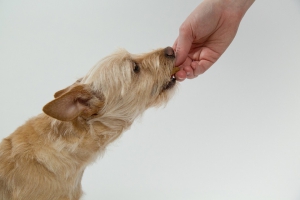If you search “how to make your own dog food,” in Google, there are 159 million results. It’s understandable why anyone considering the endeavor might be intimidated simply by the vast amount information out there – some of it, we might add, contradictory. So, where to begin? Below, we’ve broken it down to its basics, and what you need know to get started.
Much like humans, dogs thrive on a balanced diet of protein, vegetables, lots of nutrients and even dairy. It’s a good idea to consult with your veterinarian before taking on the task; they’ll help you figure out what kind of diet will best suit your furry friend.
A few rules of thumb to live by: protein rich meat should make up at least half of Fido’s diet. Beef, lamb, chicken, turkey, and buffalo are all dog-approved sources of protein. If you’re uncomfortable with handling raw meat, opt for cooked meat. Remember: dogs can eat raw chicken bones such as the neck or wing (as long as it’s not in excess) but never a cooked chicken bone, which can splinter and lodge in their intestine. It’s worth noting that dogs can eat a small amount of raw fat (around 10% is recommended) but it is much harder for canines to digest cooked fat. And most importantly: if you choose to feed your dog raw meat, make sure it’s only the highest quality. Not sure whether to grind or chop? This depends on a few factors – including how likely your pup is to eat all elements of his bowl (including the veggies) if he tends to be a grazer. Take note: raw vegetables must be puréed in a food processor or juiced in order to be properly digested.
To grain or not to grain? This depends on the dog – some pups exhibit signs of allergies or irritation towards gluten, while others don’t seem affected at all. Keep in mind that the grain, should you choose to include it, is only a small percentage of your dog’s diet. Again, we urge you to make these decisions under the guidance of your vet or canine nutritionist, as they will help you establish a diet that is whole and balanced.
Want to start with something a little easier? Try supplementing some of your dog’s dry kibble with canned salmon, sardines, or mackerel, as long as it’s canned in water and not oil. Eggs are also a great nutritious addition to their diet, and can be included in your dog’s bowl raw, or – if you’re anxious about bacteria – cooked or boiled. Lastly, yogurt, a great probiotic and source of protein, is another tasty treat for your furry pal. (Just make sure it’s plain!)
Do you make your own dog food? What do you include in his food bowl? We’d love to hear in the comments!



